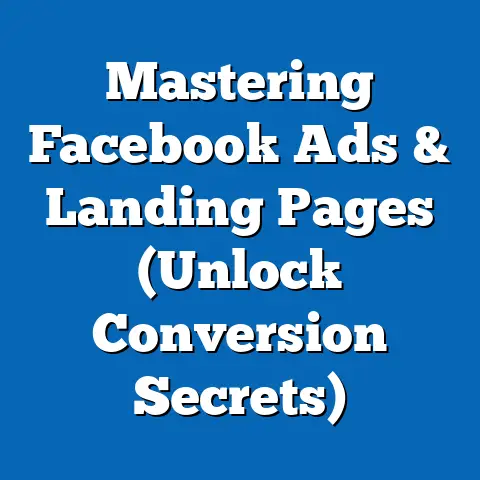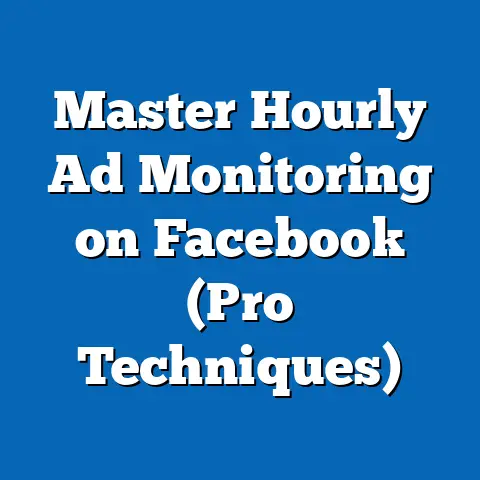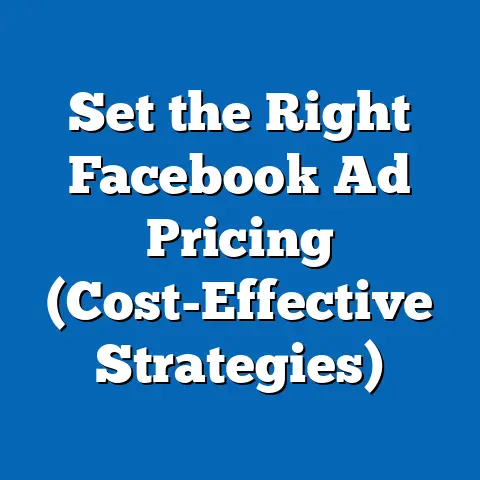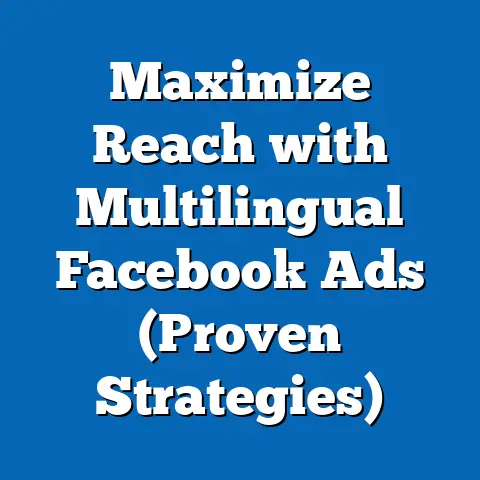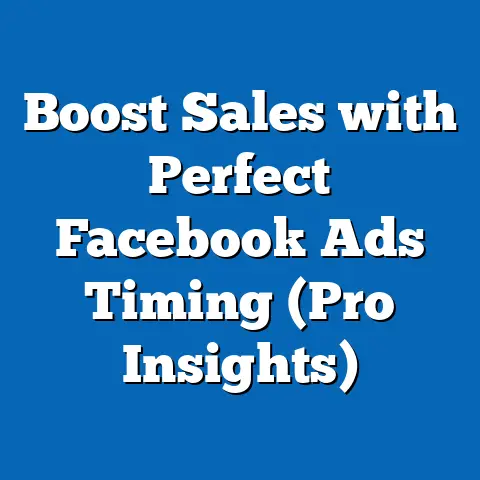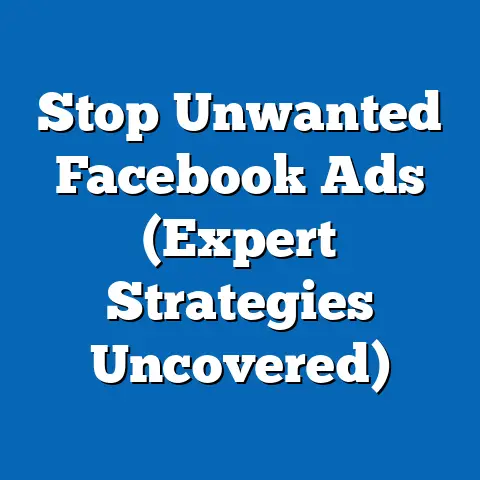Master Facebook Ads Prospecting (Proven Strategies Inside)
The business landscape today feels like navigating a turbulent sea. Shifting consumer behaviors, economic uncertainties, and a constant barrage of information make it harder than ever to connect with potential customers. In this climate, effective prospecting isn’t just a nice-to-have – it’s a lifeline. That’s where Facebook Ads come in.
I’ve seen firsthand how Facebook Ads, when wielded strategically, can cut through the noise and deliver your message directly to the people who need to hear it most. Its granular targeting capabilities, massive audience reach, and diverse ad formats make it a powerhouse for acquiring new customers. But simply throwing money at Facebook isn’t enough. You need a plan, a strategy, and a deep understanding of how to make prospecting work for you.
In this guide, I’m going to share proven strategies that I’ve used to help businesses of all sizes master Facebook Ads prospecting. We’ll dive deep into the fundamentals, explore effective campaign creation, uncover the secrets of audience targeting, harness the power of data and analytics, and master budgeting and bidding strategies. Get ready to unlock the potential of Facebook Ads and transform your prospecting efforts.
Understanding the Fundamentals of Facebook Ads Prospecting
Before we jump into the nitty-gritty of campaign creation, let’s establish a solid foundation by understanding what prospecting actually means in the context of Facebook Ads.
What is Facebook Ads Prospecting?
Prospecting, in its simplest form, is the process of finding new customers. With Facebook Ads, this translates to reaching people who haven’t interacted with your business before – they haven’t visited your website, followed your page, or made a purchase. The goal is to introduce your brand, product, or service to a completely fresh audience and pique their interest enough to take action.
Prospecting vs. Retargeting: Knowing the Difference
It’s crucial to distinguish prospecting from retargeting. While prospecting focuses on acquiring new customers, retargeting aims to re-engage with people who have already shown some interest in your business. Think of it this way: prospecting is casting a wide net, while retargeting is reeling in the fish that nibbled on your bait.
Retargeting is powerful, but it can only take you so far. To truly grow your business, you need a steady stream of new leads, and that’s where effective prospecting comes in. By focusing on acquiring new customers, you expand your potential customer base and create opportunities for long-term growth.
The Power of Audience Segmentation
At the heart of successful prospecting lies audience segmentation. You can’t effectively reach new customers if you don’t know who they are. Understanding your target market – their demographics, interests, behaviors, and pain points – is paramount.
Think of it like this: you wouldn’t try to sell snow shovels in Miami, would you? Similarly, you can’t expect to attract new customers on Facebook without tailoring your message to their specific needs and desires.
Navigating the Facebook Advertising Ecosystem
Facebook’s advertising ecosystem is a complex but powerful beast. Here’s a quick overview of the key components:
- Ads Manager: This is your central hub for creating, managing, and analyzing your Facebook Ads campaigns. It’s where you’ll define your objectives, set your budget, choose your targeting options, and track your performance.
- Audience Insights: This tool provides valuable data about your target audience, including their demographics, interests, behaviors, and page likes. It’s a goldmine for understanding your potential customers and refining your targeting strategy.
- Ad Formats: Facebook offers a variety of ad formats, including image ads, video ads, carousel ads, collection ads, and lead ads. Each format has its own strengths and weaknesses, so it’s important to choose the one that best aligns with your campaign objectives and target audience.
Takeaway: Prospecting is about reaching new customers. Understand your audience, differentiate it from retargeting, and familiarize yourself with the Facebook Ads ecosystem to lay a solid foundation for success.
Crafting Effective Ad Campaigns for Prospecting
Now that we’ve covered the fundamentals, let’s dive into the process of creating effective ad campaigns for prospecting. This is where the rubber meets the road, and where your strategic planning translates into tangible results.
Step-by-Step Campaign Creation
Creating a successful prospecting campaign involves a series of steps, each of which plays a crucial role in driving new customer acquisition:
- Define Your Campaign Objective: What do you want to achieve with your campaign? Are you looking to generate leads, drive website traffic, increase brand awareness, or promote a specific product or service? Choosing the right objective will guide your targeting, ad creative, and bidding strategy.
- Set Your Budget and Schedule: Determine how much you’re willing to spend on your campaign and how long you want it to run. Consider setting a daily or lifetime budget and scheduling your ads to run during peak hours for your target audience.
- Choose Your Targeting Options: This is where you define who you want to reach with your ads. Utilize Facebook’s targeting options to narrow down your audience based on demographics, interests, behaviors, and custom audiences.
- Create Your Ad Creative: This is the visual and textual content of your ad. Craft compelling ad copy that grabs attention and clearly communicates your value proposition. Use high-quality images or videos that are relevant to your target audience and campaign objective.
- Select Your Ad Placement: Choose where you want your ads to appear on Facebook, Instagram, Audience Network, and Messenger. Consider testing different placements to see which ones perform best for your target audience.
- Track and Analyze Your Results: Monitor your campaign performance closely and make adjustments as needed. Use Facebook’s analytics tools to track key metrics such as click-through rates, conversion rates, and cost per acquisition.
The Art of Compelling Ad Copy
Your ad copy is your chance to grab attention and convince potential customers to take action. Here are a few tips for writing headlines that grab attention and body text that converts:
- Highlight Your Value Proposition: Clearly communicate the benefits of your product or service. What problem does it solve? How will it improve your customers’ lives?
- Use Strong Action Verbs: Encourage your audience to take action by using strong action verbs like “Shop Now,” “Learn More,” “Get Started,” or “Download Now.”
- Create a Sense of Urgency: Use language that creates a sense of urgency, such as “Limited Time Offer,” “Sale Ends Soon,” or “Don’t Miss Out.”
- Keep it Concise: Get straight to the point and avoid using jargon or technical terms that your audience may not understand.
The Power of Visuals
In the world of Facebook Ads, visuals are king. High-quality images and video content can make or break your campaign. Here are a few tips for creating visuals that attract prospective customers:
- Use High-Quality Images: Avoid using blurry or pixelated images. Use high-resolution images that are visually appealing and relevant to your target audience.
- Create Engaging Videos: Video ads are a great way to capture attention and tell a story. Keep your videos short, engaging, and mobile-friendly.
- Use Eye-Catching Colors: Use colors that stand out and grab attention. Consider using your brand colors to create a cohesive visual identity.
- Showcase Your Product or Service: Use visuals to showcase your product or service in action. Show potential customers how it works and how it can benefit them.
Real-World Examples
I’ve seen countless ad campaigns that have effectively utilized these elements to drive new customer acquisition. For example, a local bakery might run an ad featuring a mouthwatering photo of their signature pastries, accompanied by copy that highlights their fresh ingredients and daily specials. A software company might create a video ad demonstrating the ease of use and powerful features of their product, accompanied by a call to action to sign up for a free trial.
Takeaway: Crafting effective prospecting campaigns requires a strategic approach, compelling ad copy, and high-quality visuals. By following these steps, you can create ads that grab attention and drive new customer acquisition.
Targeting the Right Audience
The effectiveness of your Facebook Ads prospecting efforts hinges on one crucial element: targeting the right audience. You can have the most compelling ad copy and stunning visuals in the world, but if you’re showing them to the wrong people, you’re wasting your time and money.
Unlocking Facebook’s Targeting Options
Facebook offers a wealth of targeting options that allow you to narrow down your audience based on a variety of factors:
- Demographics: Target people based on their age, gender, location, education, relationship status, and job title.
- Interests: Target people based on their interests, hobbies, and passions. Facebook uses data from user profiles, page likes, and app usage to determine their interests.
- Behaviors: Target people based on their online and offline behaviors, such as purchase history, travel habits, and device usage.
- Custom Audiences: Create custom audiences based on your existing customer data, such as email lists, website visitors, and app users. This allows you to target people who have already shown some interest in your business.
The Power of Lookalike Audiences
One of the most powerful targeting strategies for prospecting is creating lookalike audiences. This involves using your existing customer data to identify people who share similar characteristics with your best customers. Facebook then finds other users who resemble your customer base, allowing you to reach a highly targeted audience of potential new customers.
I’ve personally seen lookalike audiences dramatically improve campaign performance for many businesses. By leveraging the data you already have, you can significantly increase your chances of reaching people who are likely to be interested in your product or service.
Interest-Based Targeting: Reaching the Passionate
Interest-based targeting allows you to reach potential customers who are passionate about specific topics or activities. For example, if you’re selling fitness equipment, you might target people who are interested in yoga, running, weightlifting, or healthy eating.
The key to successful interest-based targeting is to be specific and relevant. Avoid using broad interests that are too general. Instead, focus on niche interests that are closely related to your product or service.
Real-World Impact
I’ve seen firsthand how precise targeting can transform campaign performance. Imagine a small online store selling handcrafted jewelry. By targeting women aged 25-45 who are interested in fashion, jewelry, and handmade crafts, they were able to significantly increase their conversion rates and drive new customer acquisition.
Takeaway: Targeting the right audience is crucial for successful prospecting. Utilize Facebook’s targeting options, including demographics, interests, behaviors, and custom audiences, to reach potential customers who are likely to be interested in your product or service. Don’t underestimate the power of lookalike audiences and interest-based targeting.
Utilizing Data and Analytics for Optimization
Prospecting with Facebook Ads isn’t a “set it and forget it” endeavor. It’s a continuous process of testing, analyzing, and optimizing your campaigns to achieve the best possible results. Data is your best friend in this process.
The Importance of Data-Driven Decisions
In the world of digital marketing, data is king. By analyzing your ad performance metrics, you can gain valuable insights into what’s working and what’s not. This allows you to make informed decisions about how to optimize your campaigns and improve your return on investment.
Key Performance Indicators (KPIs) to Monitor
There are a number of key performance indicators (KPIs) that you should be monitoring to track the performance of your prospecting campaigns:
- Click-Through Rate (CTR): This measures the percentage of people who see your ad and click on it. A high CTR indicates that your ad is relevant and engaging to your target audience.
- Conversion Rate: This measures the percentage of people who click on your ad and complete a desired action, such as making a purchase, signing up for a newsletter, or filling out a lead form. A high conversion rate indicates that your landing page is effective and your offer is compelling.
- Cost Per Acquisition (CPA): This measures the cost of acquiring a new customer through your ad campaign. A low CPA indicates that your campaign is efficient and cost-effective.
- Reach: This measures the number of unique people who have seen your ad. Reach is important for building brand awareness and expanding your potential customer base.
- Frequency: This measures the average number of times each person has seen your ad. High frequency can lead to ad fatigue, so it’s important to monitor this metric and adjust your targeting or ad creative as needed.
The Power of A/B Testing
A/B testing, also known as split testing, is a powerful technique for optimizing your ad campaigns. It involves creating two versions of an ad, each with a slightly different element (e.g., headline, image, targeting option), and then running them simultaneously to see which one performs better.
I’ve used A/B testing extensively to optimize various aspects of Facebook Ads campaigns. By testing different ad elements, you can identify the most effective combinations and continuously improve your campaign performance.
Facebook Analytics: Your Secret Weapon
Facebook provides a range of analytics tools that can help you gain insights into audience behavior and adjust your campaigns accordingly. These tools allow you to track key metrics, analyze demographic data, and understand how people are interacting with your ads.
Real-World Application
Let’s say you’re running a prospecting campaign for a new line of organic skincare products. You notice that your CTR is low, but your conversion rate is high. This suggests that your ad creative isn’t compelling enough to attract clicks, but your landing page is effective at converting visitors into customers. In this case, you might focus on improving your ad copy and visuals to increase your CTR and drive more traffic to your landing page.
Takeaway: Data is essential for optimizing your prospecting campaigns. Monitor key performance indicators, conduct A/B testing, and leverage Facebook’s analytics tools to gain insights into audience behavior and adjust your campaigns accordingly.
Budgeting and Bidding Strategies for Maximum ROI
Effective budgeting and bidding strategies are crucial for maximizing your return on investment (ROI) with Facebook Ads prospecting. It’s not about spending the most money; it’s about spending it wisely.
Setting a Realistic Budget
Setting a budget for your prospecting campaigns is a critical step in ensuring that you don’t overspend and that you’re able to achieve your business goals. The amount you should budget will depend on a variety of factors, including your industry, target audience, campaign objectives, and the level of competition in your market.
As a general rule of thumb, I recommend starting with a smaller budget and gradually increasing it as you see positive results. This allows you to test different targeting options, ad creative, and bidding strategies without risking a large amount of money.
Understanding Bidding Strategies
Facebook offers a variety of bidding strategies that allow you to control how much you’re willing to pay for each ad impression or click. The right bidding strategy will depend on your campaign objectives and budget.
- Manual Bidding: This allows you to set your own maximum bid for each ad impression or click. Manual bidding gives you more control over your spending, but it also requires more monitoring and optimization.
- Automatic Bidding: This allows Facebook to automatically set your bids based on your campaign objectives and budget. Automatic bidding is a good option for beginners, as it simplifies the bidding process and can help you achieve your goals more efficiently.
Tips for Effective Budget Allocation
Here are a few tips for allocating your budget effectively across different campaigns and ad sets:
- Prioritize Your Best-Performing Campaigns: Allocate a larger portion of your budget to campaigns that are generating the best results.
- Test Different Ad Sets: Create multiple ad sets with different targeting options and ad creative to see which ones perform best.
- Monitor Your Performance Closely: Track your campaign performance regularly and make adjustments as needed.
Real-World Success
I’ve seen businesses significantly improve their ROI by implementing effective budgeting and bidding strategies. For example, a small e-commerce store selling handmade candles was able to increase their sales by 30% by switching from manual bidding to automatic bidding and allocating their budget more effectively across different ad sets.
Takeaway: Setting a realistic budget and choosing the right bidding strategy are essential for maximizing your ROI with Facebook Ads prospecting. Allocate your budget effectively across different campaigns and ad sets, and monitor your performance closely to make adjustments as needed.
Conclusion
Mastering Facebook Ads prospecting is a journey, not a destination. It requires continuous learning, experimentation, and adaptation to the ever-changing digital landscape. By understanding the fundamentals, crafting effective ad campaigns, targeting the right audience, utilizing data and analytics for optimization, and mastering budgeting and bidding strategies, you can unlock the potential of Facebook Ads and transform your prospecting efforts.
I encourage you to implement the proven strategies outlined in this guide and start your journey with Facebook Ads prospecting today. Remember that success requires continuous learning and adaptation. Stay up-to-date with the latest trends and best practices, and don’t be afraid to experiment with different strategies to see what works best for your business.
Don’t wait any longer. Start your journey with Facebook Ads prospecting today and unlock new opportunities for your business. The potential is there, and with the right strategies, you can harness the power of Facebook Ads to reach new customers and achieve your business goals. Go forth and conquer the world of Facebook Ads prospecting!

